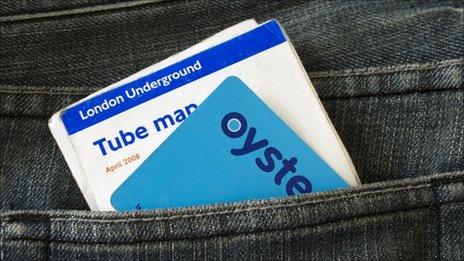Passengers taking the strain of transport costs
- Published
- comments
On Monday Ken Livingstone announced he would be dropping fares by 5% in October 2012 if elected.
And I'm told you can expect similar announcements about fares in the run-up to the mayoral election.
Immediately it means, as expected, fares are a key election battleground and places clear water between Boris Johnson and Mr Livingstone.
The mayor has said he'll stick to his formula of inflation (Retail Price Index) plus 2%; meaning at the moment an average fare rise of 7%.
He says money is needed for infrastructure investment such as Crossrail and the Tube upgrades.
It will be funded, according to Ken Livingstone, by an an operating surplus in the financial year just ended of £728m, external (.pdf).
However, Transport for London (TfL) was extremely quick to dismiss the idea and says the accounts are "obsolete" and the £728m itself has been spent on countering the cuts from the central government grant.
If this is the case, in an £8bn turnover operation there will be huge reserves that could be used. The question is: what else in terms of investment would go?
Is the question for voters: jam today or jam tomorrow?
Also, saying it has used the £728m fare surplus to counter the government grant, TfL is making a clear link between fare rises and the government cuts.
The commuter is paying for the cuts.
TfL said: "RPI+2% is the consequence of the cost of investment required to deliver these projects and the grant agreed with government through the CSR (Comprehensive Spending Review) to deliver them in the last CSR."
All of this is part of a wider picture of moving the burden from general taxpayer to the user.
My colleague, political editor Tim Donovan and his vast team of number crunchers, have unearthed some fascinating data from credit rating agency Fitch.
It shows how the farepayer is shouldering an ever increasing burden of the cost of public transport.
In TfL's case:
Fares as a percentage of total revenue (year ending 31 March):
2006: 43.6
2007: 45.4
2008: 42.3
2009: 54.2
2010: 53.7
Also note the change in transfers and grants as a percentage of total revenue including grants in this same period:
2006: 42.3
2007: 40.7
2008: 42.4
2009: 27.5
2010: 27.6
The bad news for passengers is the figures are only going one way.
- Published26 September 2011

- Published14 September 2011
